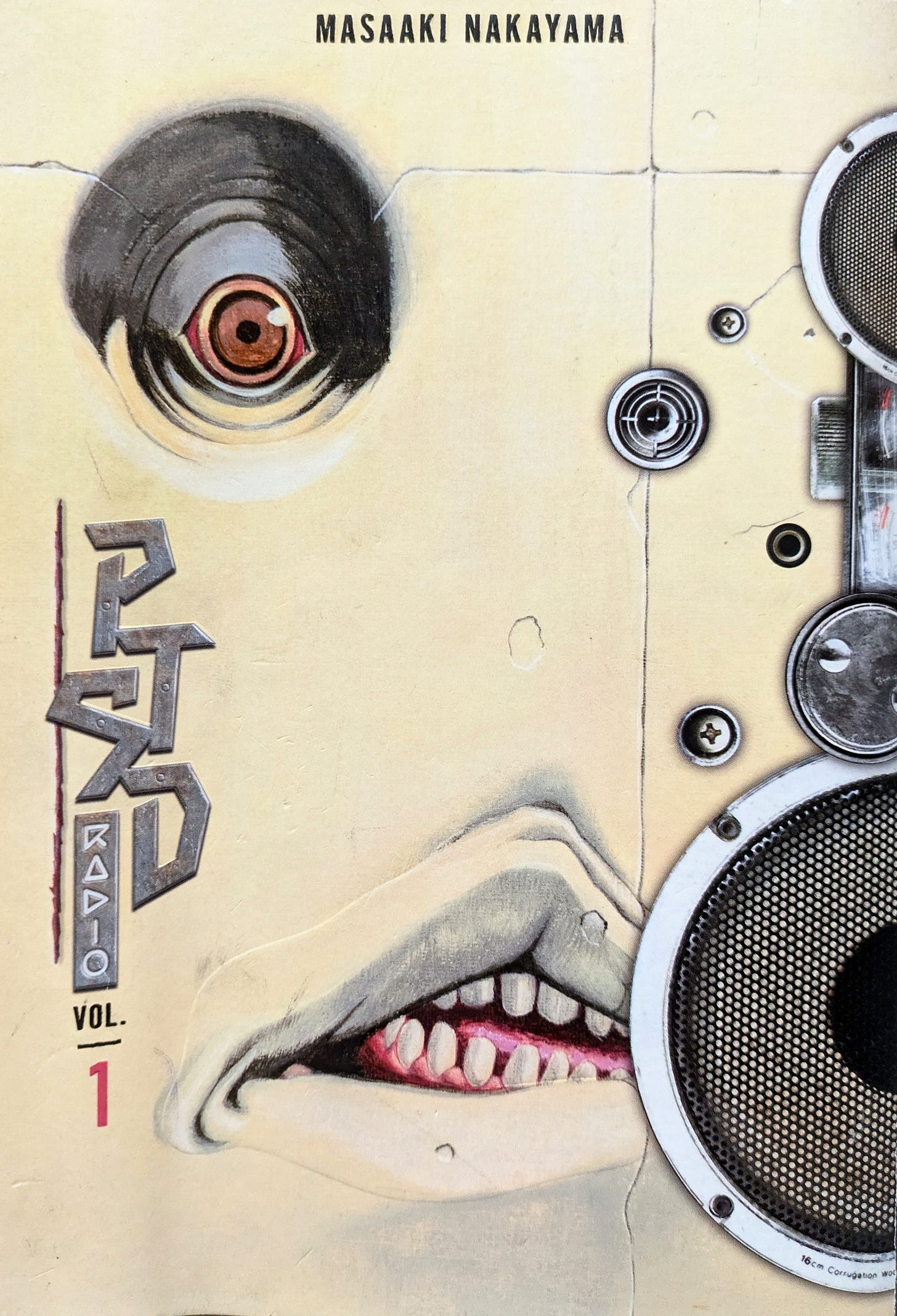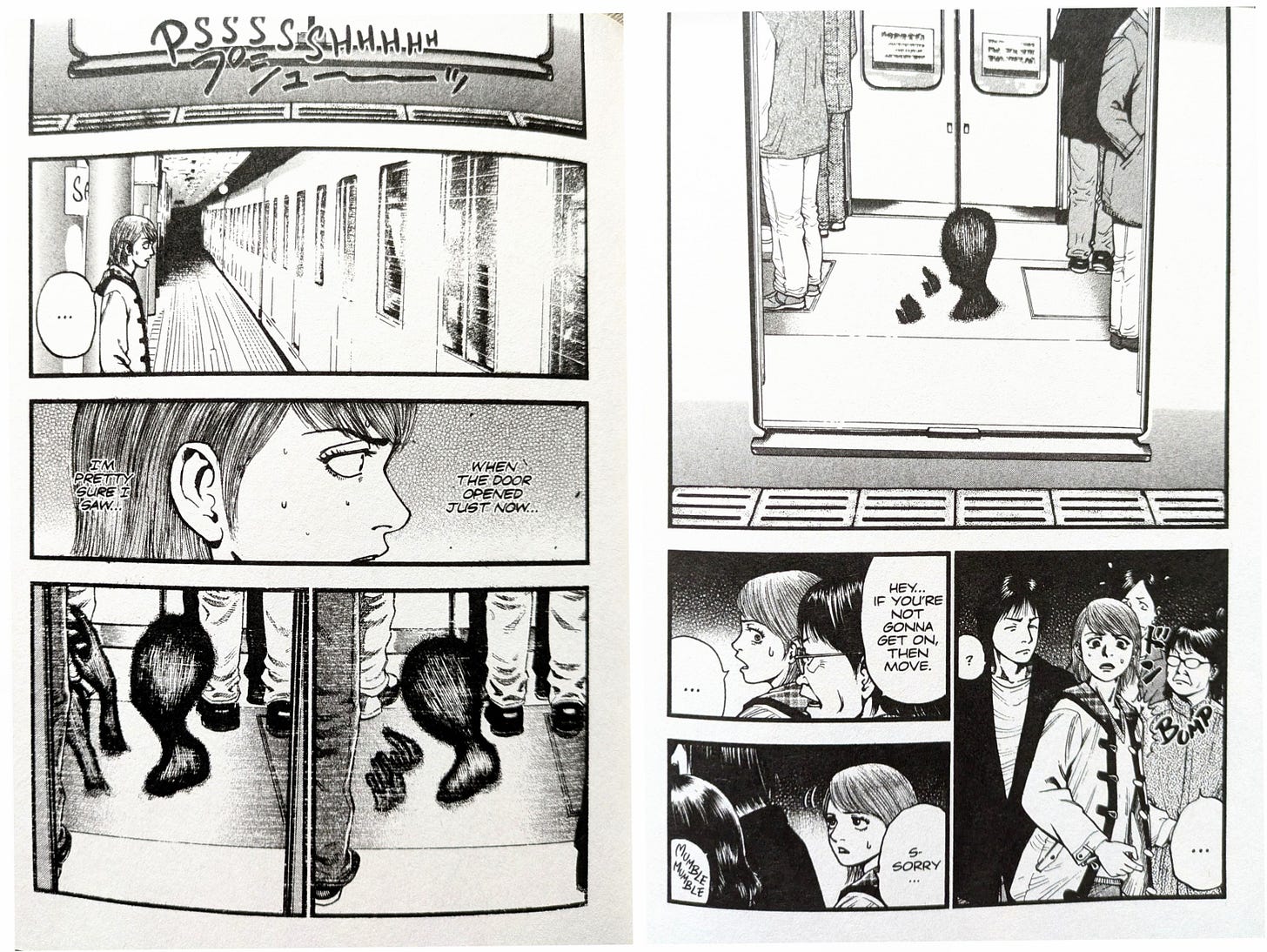Horror Analysis/ The Use of Hair Motifs in Masaaki Nakayama's PTSD Radio
Understanding how Cultural Contexts are used in Manga to terrify you//
[1] Introduction:
Japan is an ever evolving country, ‘just over 400 years ago, Tokyo was a small fishing village’ but now a technological metropolis. Despite this, pockets of Japan’s past and tradition still endure, with shrines and temples of bygone eras existing in amongst the surrounding urbanisation. It is no wonder why Japanese artists draw references from their countries mythic history, as tales of Gods and Ghosts still remain morally relevant in a modern climate. Manga is a popular conduit for these influences to appear, created for a solely Japanese audience, the origins of the themes would be instantly understood.
One such Manga is ‘PTSD Radio' by Masaaki Nakayama, a 6 volume Horror Manga (Serialising between 2012-2018) that takes from Japan’s changing culture and myth, weaving it into its core. The stories in PTSD Radio utilise a short format, along with ‘Aspect to Aspect’ panelling to quickly create a tense mood without giving the audience much information. Each chapter hosts a separate story, playing out in different eras, with characters who often go unnamed. A supernatural entity will typically appear at the end of the chapter, to torment or hurt the protagonist, except this is unseen as Nakayama frequently uses cliffhangers. These tales are unconnected and serve only to scare if viewed on a surface level, but on closer inspection, a continuous motif becomes apparent, in the form of hair.
This essay serves to contextualise Nakayama's use of hair imagery by analysis of culturally specific references. This will help to understand how history and myth can be used to create a secondary narrative, as well as to imbue graphic stories with political opinions.
[2]Chapter 1: Hair in a Social Context.
Subchapter 1: The Importance of hair in a Japanese Society/
Understanding cultural contexts when consuming international media is crucial as it effects how well the message of the work will be received. Since PTSD Radio was meant for a Japanese audience, Japanese contexts must be understood. Interviewed by the Anime News Network, Nakayama said that ‘Hair holds special meanings’ and ‘Has an intrinsic power’ which is why it's symbolism is crucial to the overarching narrative in his manga.
Many cultures place an importance on hair, seeing it as a connection to spirituality and social standing. The way one wears their hair can determine their role within society, even showing their political stance, most notably seen in 17th century England with the war between the free flowing locks of the Cavaliers versus the rigid crops of the Roundheads.
Japan is no different in this regard, important information about a person can be gathered from the way they wear their hair. This was no clearer than during the Edo period circa 1603-1868, with your hairstyle serving to communicate your age, profession, marital status and family lineage. Hair was generally tied into an updo during this period regardless of gender, as loose hair was synonymous with barbarity mainly due to the indigenous Ainu people whom the Japanese outcast, and saw as having no social standing.
While not quite as obvious as the Edo era, modern Japan still uses hair as a tool to judge where someone fits into the social hierarchy. Hair that is choppy and unkempt will signify that someone is of a working class, without a need to care for appearance, or perhaps emotionally unstable, your outside reflecting in. For a woman, a short, neat and not overly dense hairdo signifies emotional stability, respectfulness and a suitability for marriage. The inverse being someone with long, thick, dark hair is someone to be avoided, as these characteristics are a visual sign of an abundance of sexual energy and an untamable attitude- something the Japanese abhor, especially if seen in a woman.
Subchapter 2: The Social Connection between Hair and Horror/
One of the most widely recognised elements of Japanese horror is that of the Onryōu, or ‘Avenging Spirit'. The Onryōu is a malevolent ghost, usually female, whose primary goal is to exact revenge on the person/people who wronged her when she was alive. The entity is created when a woman has prematurely died before fulfilling the societal expectations laid out for her. Their physical attributes reflect this, with long, thick hair to show that she hasn't been tamed by marriage, the darkness of which signifying the failure to age into grey. The image painted is one of a lower caste Japanese woman, one who couldn't meet the pressure that a male society pushed onto her.
Tales of the Onryōu have been told for centuries originating in local spoken myth, before becoming widely recognised in Kabuki and Nōh theatre, cementing a physical image of the Onryōu into Japanese minds. Japanese cinema then adopted this characterisation, becoming mainstream through titles such as Hideo Nakata’s retelling of Koji Suzuki's novel ‘Ringu’. Created in 1998, ‘Ringu’ added a then modern take on the Onryōu tale, having the haunting entity ‘Sadako’ use technology as a conduit to exact revenge upon the humanity that scorned her. Gender politics still play a part here, but are largely overtaken by a commentary on the dangers of a newly blossoming technological Japan.
Subchapter 3: Masaaki Nakayama's interpretation of the Onryōu in ‘PTSD Radio’/
Within chapter 04 of ‘PTSD Radio', Nakayama depicts an entity sharing characteristics with the Onryōu, making itself known at an underground subway station, this can be seen in. The entity isnt inherently human in visage like the typical Onryōu, but references the feminine body in it's curvature as well as in it's openings of which are reminiscent of female genetailia. Instead of the long flowing hair associated with the trope, the entity itself if made up of dark hair acting as a shell. The vaginal openings offer glimpses to body parts hidden inside, belonging to multiple people, as well as a singular staring eye, a characteristic popularised in ‘Ringu’ as a reference to the female gaze. The result of the copious amounts of dark hair, encased appendages and a quasi-human form, is the knowledge that this twisted Onryōu isn't a singular woman hellbent on revenge, but a vehicle for many women, melding them together into one form.
Nakayama setting this story on a train station is significant, as the creature appearing to come up through the floor of the train is a reference to the high rates of suicide as a result of Japan's overwork culture, stepping in front of trains being the main way that lives are cut short. Combining these context clues together tells us of Nakayama's intent to convey the dangers of the changing roles of women in a modern Japanese society, using this Onryōu figure to tell of the effects of overwork on women whom have had to enter the male dominated workforce due to economic necessity. Death from overwork previously only affected males, but women with their societal expectations of being both a homemaker and a monetary provider are now resorting to more drastic measures. Therefore the amalgamation of women's souls are exacting revenge on the commuters, symbolically trying to rid Japan of further modernisation and as an extension more social pressures for women.
Thank you for reading,part 2 Comes Next week, where I will talk about the connection between PTSD Radio and Japanese religion and myth. Subscribe to be notified when it drops:
Question: what is your favourite piece of horror media? Let me know below!








Insightful!